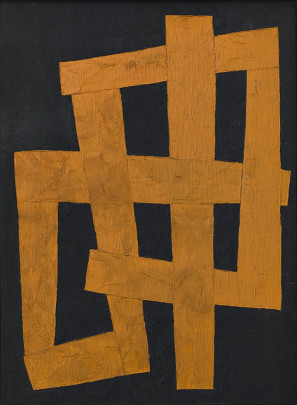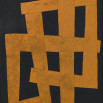山口長男 YAMAGUCHI Takeo 1902–1983
- 連続した四角 1956年 油彩・板、作家によるオリジナル額 60x45cm
Sequence of Squares 1956 oil on board, in a frame designed by the artist 60x45cm
「山口長男作品集」講談社、1981年、No.121
'Yamaguichi Takeo Sakuhin-Shu' Kodansha, Tokyo, 1981, no. 121 - 影 B 1977年 油彩・板 販売済み
Shadow B 1977 oil on board sold
京城(現・韓国ソウル市)に生まれる。21年上京し、本郷洋画研究所に学び岡田三郎助の指導を受ける。翌年、東京美術学校西洋画予備科に入学し、27年同西洋画科を卒業した。同年渡仏し、荻須高徳らと佐伯祐三を訪ね、佐伯の真剣な制作態度に刺激される一方ピカソやザッキンらのキュビスムの影響を受ける。31年帰国。前衛的な作品を二科展に出品し、38年、吉原治良らと九室会を結成する。戦後の46年京城を引き揚げて上京。二科会再建に会員として加わり、62年まで二科展に出品した。50年代以降、黒地と黄土色、又は赤茶色の2色という、限定的な色の組み合わせと、厚塗りのマティエールによって、独特の抽象形態を描いた重厚な作品を発表する。これらの仕事の独自性は高く評価され、61年度芸術選奨文部大臣賞を受賞。60年代に入ると、黒地に、より単純化された抽象形態が大きな色面を形成する画風へと展開。68年頃から、黄土色や赤茶色の色面は画面一杯に広がり、無限に広がり続けるような空間を提示するようになった。54年から74年まで武蔵野美術大学教授を務めた。
<「あるコレクターがみた戦後日本美術」展(2001~2002年、群馬県立近代美術館および愛媛県美術館を巡回)図録より引用>
Takeo Yamaguchi was born on November 23, 1902, in Seoul. He studied Western painting at the Tokyo Art School at a time when this specialization was becoming increasingly popular for incoming students. His course of study surveyed all the major European avant-garde movements of the previous two decades, and Cubism, in particular, struck Yamaguchi for its reduction of painting to a flat, monochromatic expanse. When he graduated in 1927, Yamaguchi moved to Paris and continued to study avant-garde European painting.
He returned to Tokyo in 1931, where the same specializations found at the Tokyo Art School governed artistic practice more broadly. Artists were categorized as either Western or Japanese painters, with a number of splinter groups arising from this major divide. Yamaguchi became associated with the group Nika-kai, or Second-Section Society. Formed in 1914, it opposed the official Japanese government salon, which was organized into three sections—Japanese-style painting, Western-style painting, and sculpture. Nika-kai artists protested not because of the divisions, but because of the associations they produced: Nika-kai did not advocate all Western-influenced painting, but rather an avant-garde dedication to experimentation and abstraction, and therefore came to be one of the most innovative movements in the history of modern Japanese painting. The group appealed to Yamaguchi, who on returning to Tokyo from Paris sought a more permissive environment in which to continue painting. During World War II and the Allied occupation of Japan, however, the development of avant-garde art in Japan waned to a point of nonexistence.
By the mid-1950s, the avant-garde had reemerged and Yamaguchi found his mature style. He combined the two major postwar European painting trends—Art Informel, with its thick, impasto brushstrokes, and the monochrome, with its concern for purity in painting. This combination spawned an acute sensitivity to the color, texture, and materiality of painting and moved Yamaguchi far beyond the play of depth found in Cubism. His work began to focus almost exclusively on the flatness of the canvas, which made his work attractive to Western audiences, who had become accustomed to Minimalism and Post-painterly abstraction in the 1960s. His 1969 show at the Nihonbashi Gallery, New York, for example, combined Minimalism and Conceptual art in its exhibition of 15 red monochromes simply numbered 1 through 15 along with their dimensions.
Yamaguchi's work was featured in the So Paulo Biennial (1955, 1963); Japan Pavilion, Venice Biennale (1956); Guggenheim International Award exhibition, Guggenheim Museum (1958); and The New Japanese Painting and Sculpture, Museum of Modern Art, New York (1964). He had solo shows at the Minami Gallery, Tokyo (1961, 1965, 1968, 1972, 1975), and at Nihonbashi Gallery, the first Japanese gallery established in New York (1963). Yamaguchi died on April 27, 1983, in Tokyo.
< from GUGGENHEIM - Collection Online >






